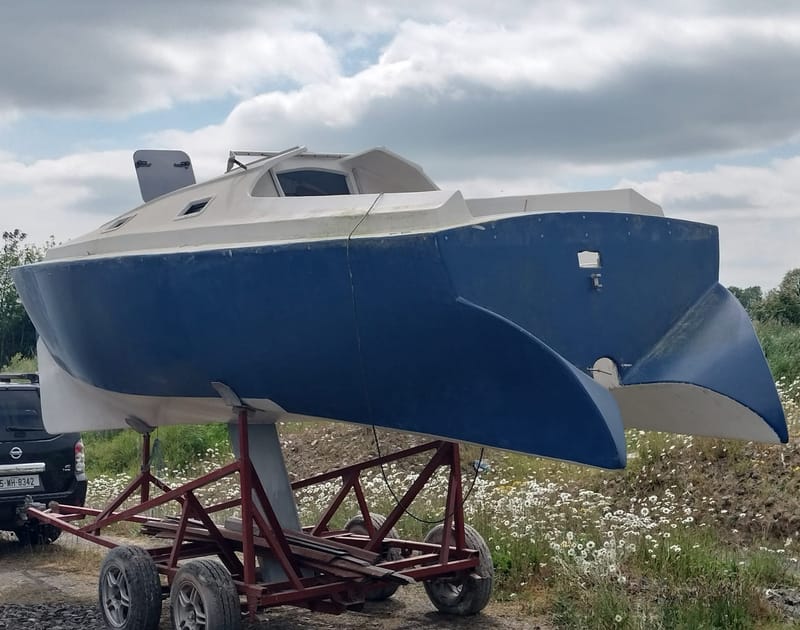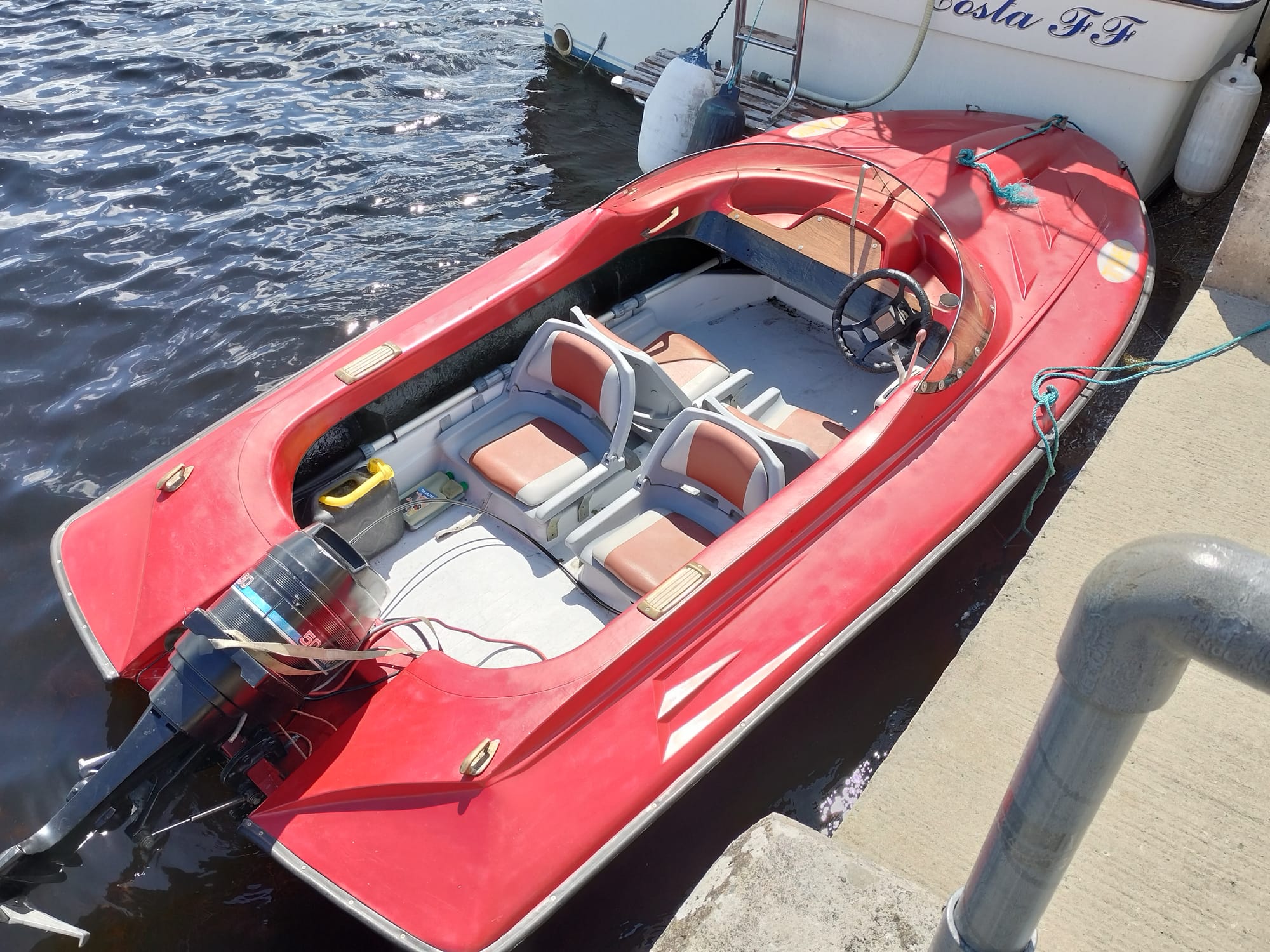Foyle Yachts
Foyle 27
Introduction
F27 Hydrodyamics
The F27 is all about hydrodynamics which is about how moving vessels interact with the varying and diverse environment of the sea. While foils simplify this by elevating the hull out of the water altogether, a vessel without them must interact with the sea and its shape is very important. Depending on what you want to do you must optimise this interaction for its intended purposes.
The purposes identified here are;
- To eliminate impact between the hull and the sea.
- To enable the hull to achieve planing speed.
- To eliminate turbulence and drag.
- To harness displacement and achieve lift at the stern.
Bow section.
The forefoot is five feet in height, from keel to deck line. It has a fine entry both horizontally and vertically. It looks like an axe head. The draft at this point goes deeper than the hull at the keel. This keeps the bow in almost constant contact with the surface and provides directional stability while avoiding slamming or pounding which is not good for the boat or its occupants.
Stern section.
The hull has a hard chine making the bottom relatively flat. Aft of the keel this becomes inverted and emerges at the transom as an arch. On either side of this there is a diminishing hydroplane which increases in draft as it narrows and becomes a fin at either side, extending past the transom by 2 feet.
The rudder is mounted on the transom between these fins which, in conjunction with the deep forefoot, contribute to directional stability and reduced leeway. The hydroplanes induce lift as they force displaced water under the stern across the rudder, controlling the release of energy from the displacement and thereby avoiding turbulence and resulting drag.
The beam carries well forward at the deck line giving abundant buoyancy when entering a wave, either on or off the wind.
Background
R n D
I started this project some years ago with no intention of designing a prototype. I had bought a donor boat, a kit built lake boat with some features that I liked and which have been retained. These are not patentable features if that worries you; just sheer line and hull features you will find on many boats and which lent themselves to what I have subsequently turned it into. The keel arrangement was poorly designed, with insufficient structure to support it; hence resulting leaks and inevitable rot. The integrity of the hull relied substantially on its coamings which did not connect adequately with the keel timbers, such as they were, which were, in turn, not well supported throughout its length, thus creating stress points that made for what must have been a very flexible and unseaworthy hull. So the sheer line and coamings were kept and a double keelson, of two 20’x9”x2” teak timbers, installed which runs fore and aft, ending at the well inside the cockpit and 2ft short of the original stem post which has been retained for added strength. The gap between the keelson and the stem post is made up with two pieces of angle iron bolted into the ends of both timbers to establish structural compression between the two. Since the coaming timbers run further forward there is no lateral weakness at this point as the keelson is tied to the coamings by way of two box steel ring frames in the way of the ballast keel and the mast compression post. The primary frames connecting the keelson to the coamings are oak and are bolted to the keelson by steel diagonals which, in turn are bolted into the ring frames and one more half ring at the companionway bulkhead. The fin keel, of 1” plate steel, with a pair of half bilge keels dowelled and welded into it at the lower end, giving a total ballast keel weight of about a half ton, with a draft of about five feet, is bolted into the keelson with eight bolts through steel plates on either side of the keelson, 5mm angle iron inserted, top and bottom, between the fin keel and keelson, all sandwiched together by two rows of bolts running through the assembly to fix the ballast keel permanently into the keelson. The possibility of installing a lifting keel will, of course, be explored at a later stage and will be an option for those wanting to sail in shallower waters.
MORE RnD
The coachroof is purpose designed to make the hull unstable in the event of becoming inverted. It is an oval section; the hull will not stay inverted, even if the sails are still on the mast. There is sufficient rigid foam in the bilge and wall cavities, under the cockpit and in the foredeck compartment to keep the hull afloat if swamped. There is a watertight bulkhead at the companionway, isolating the under seat area of the cockpit, with a further bulkhead isolating the forward section under the foredeck. So your best survival raft will be the boat itself. The foam filler also serves to reinforce the outer hull by transferring any impact to the inner panelling. It also insulates the inner hull below the water line preventing bilge water from accumulating by condensation. The production boat will, inevitably be designed to achieve similar strength characteristics with considerably less weight and will almost certainly maximise the interior space more effectively than is possible with the prototype. The cockpit is deep and well-protected from the elements, especially where the bow section is designed to go deep into oncoming waves rather than riding over them. While this will reduce pitching it may result in more water getting air borne. But rest assured; the wheels will not be coming off this wagon. Rather than hitting solid water you plough into it. Should you really like getting wet you can sit out on the cockpit back rest while watching the white bulb at the end of the keel, holding its own against a sail full of wind.
MARKETING
THE CASE FOR A VIABLE BUSINESS MODEL As fascinating as the technological factors of hull design might be, there is a wide chasm between hypothesis and reality. This can only be bridged by proof of concept. For this there must be extensive and comprehensive trials involving testing in various conditions and over varying time frames. This is not merely to find out what the concept can achieve. The trials will primarily determine if it achieves what is intended. There should also be the unexpected factors which inevitably occur with good design and which compliment those achievements, thus ensuring that the overall result exceeds expectations and does not require lowering them. The ability to plane under power is one such plus. Of course, if you are going to harness the ocean’s energy there has to be a way to do this under both sail and power. This must all then be analysed in the context of existing markets and trends to see if the concept has a viable market potential. Does it identify with what is currently in demand or does it recognise a specific latent demand not currently satisfied? If it is going to lead in a new direction it must be sufficiently novel, sufficiently exciting, to attract interest from a potential but as yet non-existent market. It will not necessarily be new but may come to the market at a time when its advantages are consistent with what people are looking for in terms of novelty and purpose; a combination of advantages that nobody else has yet thought of or came up with at the right time. Is now the right time to make adventure cruising more accessible by creating an SUV-towable, tough, safe and affordable vessel for the amateur with basic navigation experience as well as for those seeking tougher challenges?
Contact
- Pass Of Kilbride, County Westmeath, N91 A3A0, Ireland
Classic Shakespeare speed boat restored
Details
Other Projects
CLASSIC SHAKESPEARE SPEED BOAT
This project was a barn find on the shores of Blessington Lakes, Co. Wicklow in 2007. Obtained as a ‘future’ project it is now fully restored. The motor, a mid-eighties Mercury 50hp, 2 stroke, has all new electronics. There are new seats and the deck fittings, made of bronze, have been treated with bronze powder pigmented epoxy for a permanent, no-maintenance finish. Christened ‘70’s MAGIC’ it is a head turner and useful for chasing and capturing the action on the water as well as being good fun. Designed in the seventies this is probably a mid-eighties version having a false power bulge and simulated vents in the foredeck.
DETAILS
The restoration required no significant hull repair other than fibre glassing holes made in the transom and minor grazing. New multiflex bronze tinted screen split with stainless struts and penny washers. The motor wiring had been damaged by vermin. New solid state CDI unit, HT coils, magneto (non-charging), trigger, plugs, starter solenoid. Starter also restored. Launch / recovery road trailer made to fit with the axle weight allowing manual lifting of the tow hitch.
International Dragon
This project has been in the yard for some while and is about to get all the attention once others near completion. Built in 1965 at Bremen by Abeking & Rasmussen in mahogany on oak. The dead wood is essentially sound as are the keel bolts. The laminated oak scantlings require complete replacement and there are some bad joints on the sheer line. Recently acquired a boom in Burnham -on-Crouch in Essex which travelled to Duarnenez, NW France, for the 2023 Grand Prix and subsequently smuggled into Ireland on one of the Irish boats. A good suit of sails was donated through the Dragon Association.
International Tempest
Documents which came with this project show this boat as the Irish contender in the 1972 Olympics for Ireland at Kiel, Germany. These include certification of production and a letter from Ian Proctor, designer, to an earlier owner in Waterford in the 70's. Used for sail training on Lough Swilly, Donegal and Lough Ree, Athlone, by the owner, now fully restored. Single handed mast stepping and launching, reefing genoa and main. Spinnaker, road/launch trailer. A beautiful classic keelboat with Olympic pedigree.
The Ideas Man
After trying plastics design, learning German and a little about marketing in the nineties it was time to fulfil an interest in sailboats I had as a teen. Most of the ideas wont happen but some have and will.
Learn More






